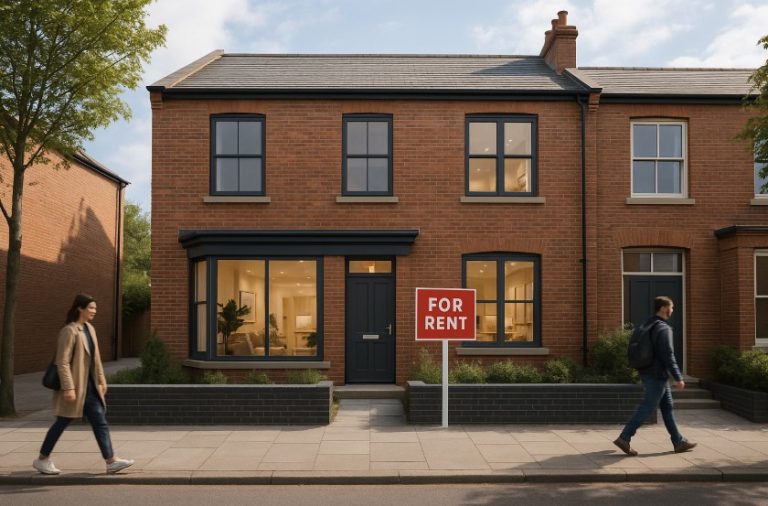Navigating the property market as a first-time buyer in the UK has never been easy and 2025 presents a complex blend of rising property prices, high mortgage rates, and cost-of-living pressures.
Government-backed schemes exist to address these challenges, but understanding which options are best suited to individual circumstances can be difficult.
This guide outlines the key government initiatives available for first-time buyers in 2025, providing essential insights to help people get on the property ladder with more clarity and confidence.
Why Government Support Matters for First-Time Buyers in the UK?
In the current housing market, the average cost of a first property in the UK exceeds £244,000. Rising interest rates, inflation, and a competitive rental sector make it difficult for new buyers to save enough for a deposit.
To combat these challenges, the UK government offers several schemes to support first-time buyers.
These initiatives aim to lower entry barriers and reduce the overall cost of home ownership by offering financial aid, reduced deposits, and long-term affordability options.
Government support is particularly relevant in 2025, as the Help to Buy Equity Loan scheme has ended and buyers are now seeking alternative routes to ownership.
The following sections explore the most effective government-backed options available this year.
What Are the Government Schemes For First-time Buyers?
1. Lifetime ISA (LISA): Boost Your Savings with Government Bonuses

The Lifetime ISA (LISA) is one of the most beneficial saving options for first-time buyers in the UK, offering a 25% government bonus to help build a property deposit faster.
It was introduced to support individuals saving for their first home or retirement, with significant tax advantages and fewer restrictions compared to older schemes.
To open a LISA, individuals must be:
- Aged between 18 and 39
- A UK resident
- Intending to use the funds for either a first property or retirement (from age 60)
You can contribute up to £4,000 per year into your LISA. The government then adds 25% of whatever you save a maximum bonus of £1,000 annually.
This amount is added automatically every month, increasing your overall savings year after year.
Withdrawals are tax-free and penalty-free if:
- You use the funds to buy your first home (worth up to £450,000)
- You are aged 60 or older and withdrawing for retirement
- You have a terminal illness
If you withdraw funds for any other reason, a 25% penalty is applied meaning you lose the bonus and a portion of your own savings.
One unique advantage of a LISA is that two people buying a property together can both use their individual LISAs and government bonuses toward the same purchase, provided both are first-time buyers.
Key Benefits of the Lifetime ISA:
- Annual bonus of 25% on contributions
- Maximum government bonus of £1,000 per year
- Tax-free interest on savings
- Can be used with another buyer’s LISA
Lifetime ISA Overview:
| Feature | Details |
| Age to open | 18–39 years |
| Max annual contribution | £4,000 |
| Government bonus | 25% (max £1,000/year) |
| Max property price | £450,000 |
| Withdrawal penalty | 25% (non-qualifying withdrawal) |
| Usage | First home purchase or retirement after age 60 |
| Account types | Cash or Stocks and Shares LISA |
2. Help to Buy ISA: Still Valid for Early Starters

The Help to Buy ISA was designed to support first-time buyers by adding a 25% bonus to their savings when used for a home purchase.
Although the scheme closed to new applicants in 2019, those who opened an account before the deadline can still use it up until 2030.
Savers using a Help to Buy ISA can:
- Deposit £1,200 in the first month
- Deposit up to £200 per month thereafter
- Earn up to £3,000 in government bonus
The bonus is paid at the time of property purchase and is applied by a solicitor during the conveyancing process. It’s not added monthly like the LISA bonus.
However, the Help to Buy ISA comes with some restrictions. The home must cost no more than:
- £250,000 outside London
- £450,000 within Greater London
This makes it less suitable for buyers in more expensive regions. In addition, if funds are withdrawn for non-home-buying purposes, the government bonus is not applied, but no penalty is imposed on the capital savings.
Main Advantages of the Help to Buy ISA:
- Government bonus of 25% (up to £3,000)
- Flexible withdrawals without penalty
- Useful for buyers with existing accounts
- Still valid for home purchases until 2030
Help to Buy ISA Summary:
| Feature | Details |
| Account status | Closed to new applicants since Nov 2019 |
| Max initial deposit | £1,200 |
| Monthly deposit limit | £200 |
| Max government bonus | £3,000 |
| Property price limit | £250,000 (£450,000 in London) |
| Bonus application | At time of property completion via solicitor |
| Last date to use for purchase | 1 December 2030 |
3. The Mortgage Guarantee Scheme: Buy with Just 5% Deposit

The Mortgage Guarantee Scheme was introduced to increase lender confidence and expand access to 95% loan-to-value (LTV) mortgages. This makes it possible for buyers with a small deposit to purchase a home, which is particularly useful for renters struggling to save large amounts.
To be eligible, the buyer must:
- Be purchasing a property to live in (not a second home or buy-to-let)
- Choose a repayment mortgage (not interest-only or offset)
- Ensure the property value does not exceed £600,000
Under the scheme, the government guarantees a portion of the mortgage. This reduces the financial risk for the lender in case of repossession, which encourages them to approve more low-deposit mortgages.
The scheme is available until the end of June 2025 and is open to both first-time buyers and home movers. However, not all lenders participate, and interest rates may be higher for 95% LTV loans compared to those with larger deposits.
Advantages of the Mortgage Guarantee Scheme:
- Only 5% deposit required
- Maximum property price of £600,000
- Open to first-time buyers and home movers
- Government-backed support improves lender confidence
Mortgage Guarantee Scheme Snapshot:
| Feature | Details |
| Minimum deposit | 5% |
| Maximum property value | £600,000 |
| Mortgage type | Repayment only |
| Eligible buyers | First-time and existing home buyers |
| Available until | 30 June 2025 |
| Government guarantee | Provided to lender on high LTV mortgages |
| Restrictions | Not available for second homes, buy-to-let, or interest-only mortgages |
4. First Homes Scheme: Discounted Property Prices for Local Buyers

The First Homes Scheme is a government initiative introduced to help first-time buyers purchase homes in their local communities at a significantly reduced cost.
This scheme is especially beneficial for those who are priced out of the market in the areas where they live or work.
Under the First Homes Scheme, eligible buyers can purchase a new-build home or a previously discounted home at a minimum of 30% off the market value.
In some cases, the discount may be as high as 50%, depending on the local authority’s housing policy. The discount is permanent it is passed on to future buyers when the property is sold, ensuring long-term affordability.
To qualify for the scheme:
- Buyers must be first-time purchasers
- The home must be used as a primary residence
- A mortgage must cover at least 50% of the discounted purchase price
- Maximum household income must not exceed £80,000 (or £90,000 in London)
- The property price after the discount must not exceed £250,000 (£420,000 in London)
Local councils may impose additional criteria, such as giving priority to key workers, members of the armed forces, or those with a strong local connection.
The key advantage of the scheme is the reduced deposit and mortgage size, making home ownership possible in otherwise unaffordable areas.
However, buyers must resell the property at the same discount percentage, and only to someone who meets the eligibility requirements.
Benefits of the First Homes Scheme:
- 30% to 50% permanent discount on eligible properties
- Lower deposit and mortgage requirements
- Priority for key workers and local residents
- Supports community stability and local workforce retention
First Homes Scheme Overview:
| Feature | Details |
| Buyer eligibility | First-time buyers only |
| Discount range | 30%–50% off market value |
| Max purchase price (post-discount) | £250,000 (£420,000 in London) |
| Mortgage requirement | At least 50% of discounted price |
| Income cap | £80,000 (£90,000 in London) |
| Resale condition | Must be sold to eligible buyer at same discount |
| Availability | England (subject to local council implementation) |
5. Shared Ownership Explained: Buy What You Can Afford

Shared Ownership is a part-buy, part-rent scheme designed for people who cannot afford to purchase a home outright.
It allows eligible buyers to purchase a share of a property, usually between 10% and 75%, while paying subsidised rent on the remaining portion owned by a housing association or local council.
This scheme reduces the upfront financial burden by lowering the required deposit and mortgage.
Buyers can secure a mortgage only for the share they’re purchasing, which makes it particularly helpful for individuals on lower incomes or with limited savings.
Key points about Shared Ownership:
- Available to first-time buyers or those who used to own a home but can’t afford one now
- The combined household income must be less than £80,000 (or £90,000 in London)
- Rent is paid on the remaining share (usually subsidised)
- Buyers are responsible for 100% of repairs and maintenance, regardless of their ownership share
One of the standout features is staircasing the ability to purchase additional shares of the property over time.
This allows the buyer to eventually own 100% of the home, at which point they no longer need to pay rent.
However, Shared Ownership does come with some restrictions. When selling the property, the housing provider usually has the first right of refusal or may require the home to be sold to another eligible buyer. There may also be service charges on top of mortgage and rent payments.
Advantages of Shared Ownership:
- Smaller deposit and mortgage requirement
- Flexible ownership: start with a smaller share and increase over time
- Suitable for low to middle-income households
- Offers a pathway to full home ownership
Shared Ownership Summary:
| Feature | Details |
| Initial share | 10% to 75% of property value |
| Income eligibility | Under £80,000 (£90,000 in London) |
| Monthly payments | Mortgage on owned share + rent on remaining share |
| Staircasing | Allowed in increments, up to full ownership |
| Responsibility for repairs | 100% (even if owning part of the property) |
| Sale restrictions | First refusal to housing provider; eligible buyers only |
| Availability | England, Scotland, Wales, Northern Ireland |
6. Right to Buy & Right to Acquire: Turning Tenants into Owners

The Right to Buy and Right to Acquire schemes are long-standing government initiatives aimed at helping social housing tenants transition into home ownership by purchasing their current homes at discounted rates.
Right to Buy (England)
Right to Buy is available to council tenants in England who have rented for at least three years (not necessarily consecutively). The longer the tenancy, the larger the discount up to a maximum of £96,000 in London and £87,200 elsewhere in England.
The discount is calculated based on:
- The property type (house or flat)
- Length of tenancy
- Property valuation
Right to Buy allows tenants to purchase their home outright at a significantly reduced price, offering a rare opportunity to own without the need to move or pay full market value.
Right to Acquire
Right to Acquire is similar to Right to Buy but is aimed at housing association tenants. The discounts are smaller usually between £9,000 and £16,000 and eligibility criteria vary depending on the housing association and property location.
Eligibility requires:
- A minimum of three years of tenancy in a qualifying property
- The property must be built or purchased by a housing association after a specific date (usually post-1997)
- The home must not be in a rural protected area
Both schemes require that buyers take out a mortgage or pay in full from their own funds. There may be restrictions on reselling the property within the first five years, during which the discount may need to be repaid partially or fully if the home is sold.
Advantages of Right to Buy / Acquire:
- Significant discounts for long-term tenants
- Enables ownership of a familiar home
- No need to move or search for a new property
- Discount can be used as part of a mortgage deposit
Right to Buy & Right to Acquire Summary:
| Feature | Right to Buy | Right to Acquire |
| Eligible tenants | Council tenants (England) | Housing association tenants |
| Minimum tenancy | 3 years | 3 years |
| Discount amount | Up to £96,000 (London), £87,200 elsewhere | £9,000 to £16,000 |
| Property type | Must be tenant’s primary home | Must meet specific ownership criteria |
| Resale restrictions | Discount repayment if sold within 5 years | Same as Right to Buy |
| Availability | England (Right to Buy) | England, selectively by region (Right to Acquire) |
7. Own New – Rate Reducer: Lower Interest on New Builds

The Own New – Rate Reducer scheme is a private-sector initiative introduced to support homebuyers purchasing new-build properties by making mortgage payments more affordable, particularly in the early years of ownership.
It is available to both first-time buyers and existing homeowners and works in partnership with selected homebuilders and mortgage lenders across the UK.
At its core, the Rate Reducer uses a housebuilder’s financial incentives to effectively reduce the interest rate on a buyer’s mortgage.
Rather than offering cashback or a discount on the property price, the housebuilder instead contributes toward reducing the buyer’s mortgage rate potentially significantly for a fixed term, usually between 1 to 5 years.
How Rate Reducer Works?:
- A housebuilder offers an incentive (often 3% to 5% of the property price)
- This incentive is transferred directly to the mortgage lender
- The lender applies the incentive to lower the mortgage interest rate, reducing monthly repayments
This approach offers buyers immediate relief from high interest rates a key concern in 2025’s economic climate without reducing the property’s headline value, which could affect future valuations or resale potential.
Example Scenario:
A buyer purchases a new-build home worth £350,000. The housebuilder offers a 5% incentive (£17,500). Instead of deducting this amount from the house price, it is applied to lower the mortgage rate.
This could reduce a mortgage interest rate from 4.79% to as low as 0.99% over a 2-year fixed period, saving the buyer hundreds of pounds per month.
Key Features:
- Available only on new-build homes
- Buyers must use participating lenders and developers
- The lower interest rate is temporary, and normal rates resume after the term ends
- Buyers need to plan ahead for future increased repayments once the reduced rate expires
This scheme is best suited for buyers who are confident about their income growth or expect to remortgage after the deal ends. While the short-term savings can be significant, careful budgeting is essential to avoid financial strain when the rate resets.
Advantages of Own New – Rate Reducer:
- Makes new-build homes more affordable in early years
- Reduces monthly mortgage payments without needing a larger deposit
- Allows developers to help buyers without discounting property value
- Available to both first-time buyers and movers
Own New – Rate Reducer Summary:
| Feature | Details |
| Property type | New-build homes only |
| Eligible buyers | First-time buyers and existing homeowners |
| Incentive source | Housebuilder (typically 3%–5% of property price) |
| Effect of incentive | Reduces mortgage interest rate |
| Participating lenders | Limited (e.g. Halifax, Virgin Money, others) |
| Duration of reduced rate | Usually 1–5 years |
| Key benefit | Significantly lower monthly payments during initial period |
| Long-term consideration | Rate increases after term ends; plan for future affordability |
8. New Build Boost: Bridge Your Deposit Gap

New Build Boost is another targeted scheme for homebuyers who want to purchase a new-build property but face difficulties saving a large enough deposit to access lower mortgage rates. Offered in partnership with specific developers such as Persimmon and Charles Church, this scheme combines a traditional mortgage with an interest-free equity loan to boost the buyer’s deposit.
This is not a government-backed initiative but functions similarly to past schemes like Help to Buy Equity Loan. It’s intended to help buyers reach the commonly required 80% loan-to-value (LTV) mortgage level, which typically comes with more competitive interest rates compared to high LTV products like 90% or 95%.
How New Build Boost Works?:
- Buyers contribute a 5% to 15% deposit from their own savings
- The developer provides an interest-free equity loan to top this up to 20%
- The buyer then secures an 80% mortgage from a lender
- The result is lower monthly payments thanks to a better mortgage rate
Unlike Shared Ownership or Help to Buy, buyers own 100% of the property from day one. There’s no rental element, and the home is entirely in the buyer’s name.
However, the equity loan is repaid when the property is sold, remortgaged, or at the end of the mortgage term. After five years, the loan value is linked to the home’s market value, meaning repayments could rise if the property appreciates in price.
Eligibility Criteria:
- Open to first-time buyers and existing homeowners
- Must purchase a new-build property from a participating developer
- Requires a minimum 5% deposit (can be savings or gifted)
- Not currently available in Scotland or Wales
This scheme is ideal for buyers who can afford monthly repayments but are short on savings. The combination of an interest-free loan and an 80% mortgage provides both affordability and full ownership with the flexibility to repay or refinance when financially ready.
Advantages of New Build Boost:
- Makes it easier to access lower interest-rate mortgages
- Requires a smaller personal deposit
- No shared ownership or rent payments
- Full ownership from day one
- Equity loan is interest-free for the full mortgage term
New Build Boost Summary:
| Feature | Details |
| Property type | New-build homes (Persimmon, Charles Church) |
| Eligible buyers | First-time buyers and home movers |
| Minimum buyer deposit | 5% (can be savings or gifted) |
| Equity loan | Interest-free, from developer |
| Total deposit to lender | 20% (buyer + equity loan) |
| Mortgage amount | 80% LTV |
| Ownership | Full (100%) from the beginning |
| Regional availability | England only (not available in Scotland or Wales) |
| Repayment of loan | On sale, remortgage, or end of mortgage term |
Overview of Major First-Time Buyer Schemes:
| Scheme | Min Deposit | Max Property Value | Key Benefit | Available In |
| Lifetime ISA | £0 | £450,000 | 25% savings bonus | UK |
| Help to Buy ISA | £0 | £250,000 (£450k in London) | 25% bonus on savings | UK (existing users) |
| Mortgage Guarantee | 5% | £600,000 | 95% LTV mortgages with guarantee | UK |
| First Homes | Varies | £250,000 (£420k in London) | 30–50% discount on new builds | England |
| Shared Ownership | 5–10% | Varies | Buy part, rent the rest | UK |
| Right to Buy/Acquire | Varies | Varies | Discount for social housing tenants | England, N. Ireland |
| Own New Rate Reducer | Varies | Varies | Temporary low-interest mortgages | England |
| New Build Boost | 5–15% | Varies | Equity loan boosts deposit | England (selected areas) |
Regional Schemes Across the UK: What’s Available Near You

While many national housing schemes apply across the UK, each country within the UK, England, Scotland, Wales, and Northern Ireland, also offers its own region-specific initiatives to support first-time buyers.
These schemes are tailored to reflect the distinct housing needs, income levels, and property markets in their respective areas.
Here’s a breakdown of the key regional schemes for first-time buyers in 2025, covering local eligibility, benefits, and structure.
England
England offers several schemes outside the major national programmes. Two options stand out for specific groups of buyers:
Home Ownership for People with Long-Term Disabilities (HOLD)
HOLD is part of the Shared Ownership scheme and is specifically aimed at buyers with long-term disabilities whose housing needs cannot be met through the standard properties available in other shared ownership programmes.
Key features:
- Buyers can choose any home on the open market (within budget)
- Available only if other Shared Ownership homes don’t meet disability-related needs (e.g. need for a ground-floor or accessible home)
- Shared ownership structure applies: part purchase, part rent
This scheme offers enhanced flexibility and a wider choice of properties, crucial for those with specific accessibility needs.
Older People’s Shared Ownership (OPSO)
This variant of Shared Ownership is aimed at individuals aged 55 and above. It follows the same general structure as the standard Shared Ownership scheme but comes with additional benefits.
Key features:
- Buyers can purchase up to 75% of the home’s value
- Once 75% ownership is reached, no rent is paid on the remaining share
- Designed to support older adults looking to downsize or find age-appropriate housing
This is an excellent option for older buyers who want security, lower living costs, and partial ownership in retirement without full financial responsibility.
Scotland
Scotland operates two shared equity schemes designed to assist low to moderate-income buyers in accessing affordable homeownership.
New Supply Shared Equity Scheme (NSSE)
The NSSE helps eligible buyers purchase newly built homes from housing associations, local councils, or private developers.
Key features:
- Buyer pays majority share (60% to 80%)
- Scottish Government funds the rest as an equity loan
- No interest or rent is charged on the government’s share
- Repayment occurs upon sale or voluntary equity buyout
The scheme is aimed at first-time buyers, disabled people, social renters, and armed forces personnel, with price caps that vary by location.
Open Market Shared Equity Scheme (OMSE)
Unlike NSSE, OMSE allows buyers to purchase homes on the open market, not just new builds, within local price thresholds.
Key features:
- Buyer contributes 60% to 90% of the purchase price
- The Scottish Government provides an equity loan for the remainder
- The loan is repaid when the property is sold or ownership is transferred
OMSE is particularly helpful in rural or high-demand areas where new-build options are limited or unavailable.
Wales
The Welsh Government provides multiple schemes, including Shared Ownership – Wales and Homebuy – Wales, each aimed at making home ownership feasible for households with modest incomes.
Shared Ownership – Wales
This scheme operates similarly to Shared Ownership in England and allows buyers to purchase a portion of a home and rent the rest.
Key features:
- Buyers can purchase between 25% and 75% of the property
- Rent is paid on the unowned portion
- Households must earn £60,000 or less per year
- Available through participating housing associations
Staircasing is permitted, allowing buyers to increase ownership over time. It provides a flexible path to full ownership for low to middle-income families.
Homebuy – Wales
Homebuy – Wales offers equity loans to help people who cannot afford to purchase a home on the open market, even with a mortgage.
Key features:
- Buyers typically pay between 70% and 80% of the property price
- The remaining portion is funded by an interest-free equity loan from the local authority
- Loan repayment is due upon sale or transfer of ownership
- Scheme availability is subject to local authority discretion and funding
It is primarily targeted at existing social tenants, key workers, and people with a strong local connection, but criteria can vary by region.
Northern Ireland
Northern Ireland offers two main housing support options: Co-Ownership and the House Sales Scheme. Both aim to promote affordable home ownership, particularly among long-term tenants and low to middle-income earners.
Co-Ownership
Co-Ownership is Northern Ireland’s version of shared ownership. It allows buyers to purchase between 50% and 90% of a property and rent the remaining portion from Co-Ownership Housing.
Key features:
- Buyers can increase ownership over time in 5% increments (“staircasing”)
- Available for both new-build and resale properties
- Household income must support mortgage repayments but be below limits for full purchase
- Government support keeps rent lower than market rates
Co-Ownership provides an ideal route into ownership for individuals or families who are mortgage-ready but don’t have the funds for full market value.
House Sales Scheme
This is Northern Ireland’s version of Right to Buy and is available to long-term tenants of the Northern Ireland Housing Executive or registered housing associations.
Key features:
- Tenants can buy their home after five years of occupancy
- Discounts start at 20% and increase annually, up to 60% or a maximum of £24,000
- The property must be the buyer’s main residence
This scheme supports stable, long-term tenants who wish to convert their rented property into a permanent home with full ownership.
Summary of Regional First-Time Buyer Schemes
| Region | Scheme Name(s) | Key Features & Benefits |
| England | HOLD, Older People’s Shared Ownership | Tailored for disabled and older buyers, shared ownership with reduced or no rent |
| Scotland | NSSE, OMSE | Equity loan assistance for new builds and open-market homes, no interest or rent |
| Wales | Homebuy – Wales, Shared Ownership – Wales | Equity loans or part-rent options, income caps apply, staircasing allowed |
| Northern Ireland | Co-Ownership, House Sales Scheme | Flexible part-ownership, rent on balance, discounts for long-term tenants |
Conclusion
With property affordability remaining a significant hurdle in 2025, these government schemes can provide real, tangible support to help first-time buyers take their first steps onto the property ladder.
Choosing the right scheme depends on income, savings, location, and personal goals. Buyers should carefully assess eligibility, costs, and long-term commitments before proceeding.
Combining financial planning with the right support can make home ownership a realistic goal this year.
FAQs on Government Schemes for First-Time Buyers in the UK
What is the difference between a Lifetime ISA and Help to Buy ISA?
While both offer a 25% bonus, Lifetime ISAs allow higher annual contributions and have a longer window for savings. Help to Buy ISAs are no longer available to new applicants.
Can I use more than one government scheme at the same time?
Generally, you cannot combine multiple purchase-related schemes (e.g., Shared Ownership and First Homes), but you can combine savings schemes (like LISA) with purchase schemes.
Is Shared Ownership better than buying outright?
Shared Ownership offers a lower barrier to entry but comes with restrictions on selling and responsibilities for maintenance. It’s ideal for those with low deposits or income.
Are there schemes for people with disabilities?
Yes, the HOLD scheme supports buyers with long-term disabilities when standard Shared Ownership homes are not suitable.
How does staircasing work in Shared Ownership?
Staircasing allows buyers to purchase more of their property over time, eventually achieving full ownership if desired.
Is Right to Buy still active in the UK?
Yes, but it’s only available under specific conditions depending on tenancy type and location. Northern Ireland and England both offer variations of this scheme.
Are new-build schemes better than buying second-hand homes?
Schemes like First Homes and Own New typically apply to new builds, which come with guarantees and lower maintenance but may cost more initially than older properties.






